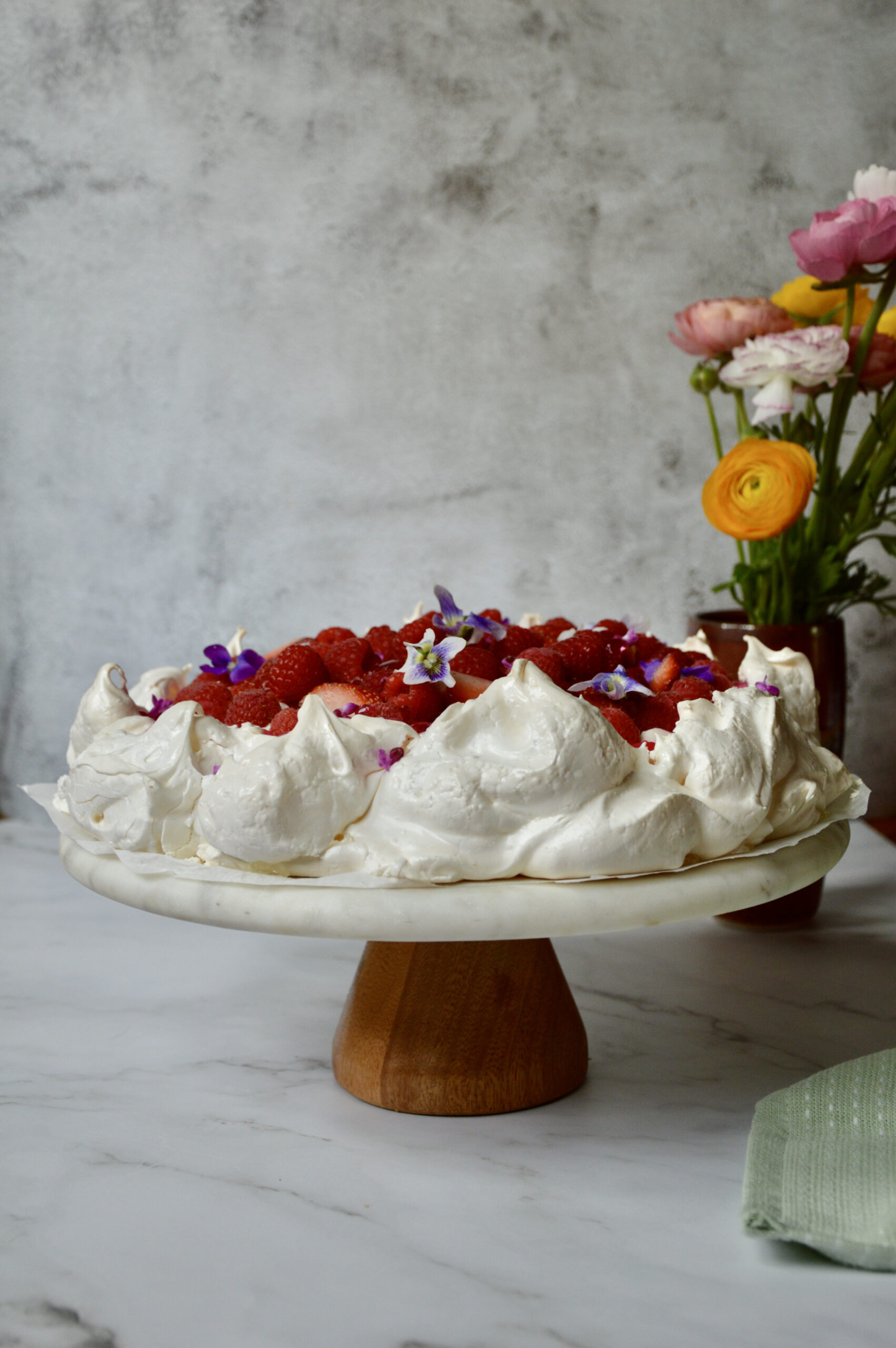
Tart rhubarb curd cuts through the sweetness of this fanciful dessert. A fun dish for Easter and Passover-friendly, Pavlova is the perfect vehicle to celebrate all things seasonal.
I first discovered this dessert the way many of my fellow Americans probably did, watching The Great British Bake-Off. Though I enjoyed watching contestants pipe and swirl mounds of stiff, sweetened egg whites, I didn’t feel inclined to make the dessert myself until I met my partner and started celebrating Passover with his family. Now, every spring I look for a new Passover-friendly dessert to try my hand at.Our niece and nephew love the children’s show “Bluey” and Pavlova, a popular dessert in Australia (and the National Dessert of New Zealand!) is featured in an episode leading— said niece and nephew to ask for this dessert, which they describe as a “crunchy, yummy cake with fruit.”
They aren’t far off in their description. Egg whites are whipped with sugar and vanilla into stiff peaks, then swirled into a crown atop a baking sheet. The pavlova is then baked at a low temperature until the meringue is firm to the touch. Whipped cream, tart rhubarb curd and seasonal fruit give this dessert depth. Once you master the meringue, you can make this often, switching out rhubarb for lemon or passionfruit curd in the winter and garnishing with candied orange and some chopped pistachios. Foraged seasonal flowers such as violets, redbud blooms or wild mustard add whimsy and a pop of color, and it’s a great way to get out of the kitchen and into nature.
Note: when foraging for edible blooms, please remember to identify carefully, take only what you need and leave the rest for the pollinators to enjoy.
Recipe by Lisa Archer
Ingredients
Makes one 9-10 inch Pavlova
¾ teaspoon cream of tartar
1 ⅕ teaspoons cornstarch
6 egg whites (yolks reserved for fruit curd), room temperature
1 1/4 cups granulated sugar
1 teaspoon lemon zest
1 ½ teaspoons vanilla extract
Toppings:
2 cups fresh seasonal fruit
1 ½ cups whipped cream
1 cup rhubarb or other fruit curd
Edible flowers to garnish
INSTRUCTIONS
- Preheat oven to 350 ℉. Trace a 9-10 inch circle on a sheet of parchment paper and place on a baking sheet. Mix cornstarch and cream of tartar in a small bowl and set aside.
- Place egg whites in the bowl of a stand mixer and whisk on medium-high until soft peaks form, about 5 minutes. Add the sugar in two additions, whisking for 30 seconds between each addition. Increase mixer speed to high and whisk until meringue turns glossy and stiff peaks form, about 3 minutes. Add vanilla and lemon zest and whisk on high for one more minute. Remove bowl from mixer stand and using a spatula, gently fold in cream of tartar and cornstarch.
- Spread* meringue into a round on the parchment paper, using the traced circle as a guide. Make sure the walls of the meringue are higher than the center so you have a shallow “bowl” to place toppings in.
- Place meringue in oven and immediately turn oven down to 225 ℉. Bake meringue until it is firm to the touch, about 90 minutes. Turn off oven, and allow meringue to cool in the oven for one hour (this keeps the meringue from cracking badly).
- Spread whipped cream or fruit curd** in the “bowl” of the meringue. Fill with seasonal fruit and decorate with edible flowers. Store refrigerated for up to one day (the toppings will cause the meringue to soften.
*you can also use a pastry tip and piping bag to pipe the meringue for a more uniform look.
** you can make your own rhubarb or lemon curd or purchase from your favorite local retailer. Curd may also be omitted, just add another cup of seasonal fruit to the filling.
